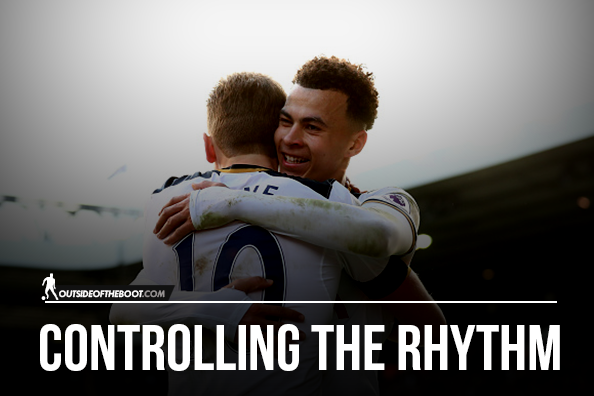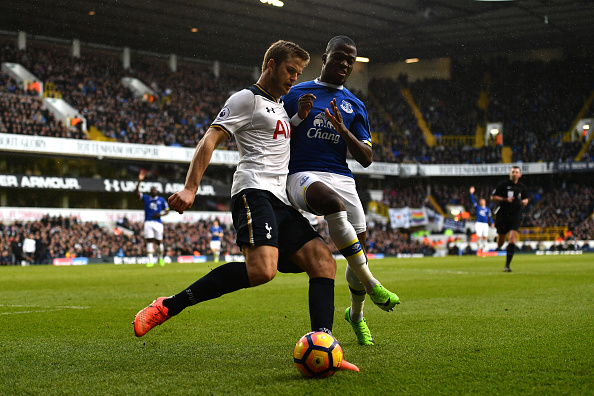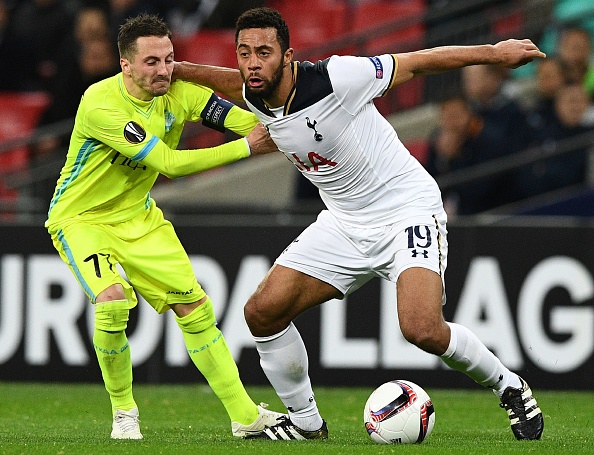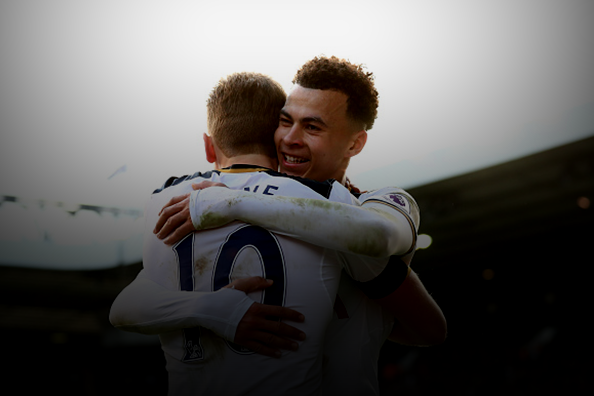Valentin Schwarz writes about Tottenham and their ability to control the rhythm and tempo of a game.
A few weeks ago Sauharda Karki wrote an insightful article on this site about a crucial feature of modern top teams, the ability to control the rhythm of matches. Often the term “dominance” is only attributed to teams that rack up huge possession numbers, although that itself does not capture the truth entirely. Of course possessing the ball and dominating a match often coincides. The best example for this are obviously the teams of Guardiola (to different levels), who saw and see the ball in the vast majority of nearly every match they are playing. But even with them, the possession itself was never the decisive factor. Instead their defining feature is the brilliant positional structure, the Juego de Posicion, which leads to various options for combinations with the ball and a perfect starting position for the counterpressing after losing it. The possession numbers are only a byproduct, the logical conclusion of the Juego de Posicion. And then there are teams that are dominating matches, i.e. controlling the rhythm, even without having the ball by either forming a compact defense out of which they start different kinds of attacks (counterattacks, precise long balls, attacks with an increased focus on build-up), as Juventus does very well, or by implementing an aggressive attacking press and counterpress, combined with rapid vertical attacks after winning the ball. The teams of Klopp come to mind, so it´s no wonder that this strategy became very popular in the Bundesliga after his success with Dortmund (the ones doing it best this season are probably RB Leipzig). Of course combinations of these styles can also be successful, which is demonstrated by the two Madrid clubs. Atletico frequently changes the height and intensity (but never the compactness) of their pressing and thanks to their amazing execution they can change the pace this way. Real can go from a slow build up that shows no signs of danger to powerful vertical attacks in the matter of seconds. All in all it´s safe to say that the vast majority of elite teams in the European top leagues and the international competition are able to control the rhythm in one way or the other.

A relatively new member in this group is Tottenham Hotspur. Their match last weekend against Everton has once against showcased that they have added that quality to their game and have become one of the best sides in the Premier League in the process. During the opening twenty minutes they focused on slowing the game down by keeping the ball with clean build up and a good positional structure, thereby destroying all possible Everton attacks before they even started through effective counterpressing. After the talismanic Harry Kane scored from outside the box, they switched to another gear. Now almost every pass was played forward and the intensity and aggressiveness of the pressing and counterpressing was increased even more. Everton seemed completely overwhelmed by this change of pace and so their defense helplessly faced one attack after another. In this period of the match the Spurs bore a strong similarity to Klopp´s Dortmund. Tottenham could have easily led by two or three goals by the time the halftime whistle arrived, but it took them until ten minutes into the second half to make the lead more comfortable. This goal exemplified the characteristics of Tottenham´s approach. When Everton keeper Joel Robles played the ball to Morgan Schneiderlin in the center of the pitch around thirty yards ahead in front of his goal, Moussa Dembele immediately sprinted forward and pressed the French midfielder. So Schneiderlin, after receiving the ball, was forced to play a short pass to Ashley Williams. Dele Alli anticipated what was going to happen, went outside to the blind spot of Williams in exactly the right moment to intercept the pass and played an easy through ball to Harry Kane, who had already positioned himself for that occasion and finished the job in a one-on-one against Robles. After that goal Tottenham slowed down the game again and ended it the way they had started it. Although Romelu Lukaku shortened the lead ten minutes before the end of the regular time and both teams scored again in injury-time, the win was never really in danger. It was a stellar performance by the Spurs with regard to how they decided the rhythm of the match and how well they executed the different approaches. There are three factors that have to be emphasized in their development that has led to performances like this one with an increased consistency.

LONDON, ENGLAND – MARCH 05: Eric Dier of Tottenham Hotspur is closed down by Enner Valencia of Everton during the Premier League match between Tottenham Hotspur and Everton at White Hart Lane on March 5, 2017 in London, England. (Photo by Dan Mullan/Getty Images)
Pochettino’s strategy
During his stint at the White Hart Lane, which started in 2014, the Argentine manager´s outfit has made significant improvements in both the defensive and offensive phases of the game. His main achievement is the implementation of a functional positional structure. In possession, spacing is given either by the wing backs or the offensive midfielders, the central midfielders always offer a short option for the center backs and the offensive midfielders Alli and Eriksen are drifting through the important half spaces and offer a connection forward. The presence of Harry Kane, who also sometimes drops to the ten-space, creates opportunities for runs in the box by other players, a situation in which Alli excels. After losing the ball the Spurs use their positioning in the important parts of the pitch to counterpress aggressively. Pochettino also has to be given credit for the intensity with which they act against the ball, a key quality for an effective counterpressing and a compact regular pressing. These principles allow them to execute various approaches to a match on a high quality standard and control the pace, as is shown by the Everton match.
The individual quality

Gent’s Swiss midfielder Danijel Milicevic (L) vies with Tottenham Hotspur’s Belgian midfielder Mousa Dembele (R) during the UEFA Europa League Round of 32 second-leg football match between Tottenham Hotspur and KAA Gent at Wembley Stadium in north London, on February 23, 2017. / AFP / Justin TALLIS (Photo credit should read JUSTIN TALLIS/AFP/Getty Images)
Many of Tottenham´s key players are still relatively young, but possess numerous strategic and tactical qualities in addition to technical and physical ones. Much has been said already about the leadership and consistency of Hugo Lloris, Jan Verthonghen and Toby Aldeweireld, the brilliant positioning and exquisite technique of Alli and Christian Eriksen, and the goalscoring record of Kane, so I´m focusing here on three other important players which are in the starting lineup almost every match. Kyle Walker, Moussa Dembele and Victor Wanyama combine great athleticism with dynamic dribbling abilities (the latter goes especially for the first two). As a result they are very useful in keeping possession through their pressing resistance, as well as in starting rapid attacks by carrying the ball forward through traffic and in the pressing game (see Dembele in the second goal against Everton). Although they are not the most talked about Spurs players, their qualities are of immense value for the control of the rhythm.
The formational variability
While a 4-2-3-1 with three fluid offensive midfielders was the common Spurs formation during the last two seasons, that has changed lately. With Erik Lamela injured and Heung-Min Son losing his great form of the second half of 2016, Pochettino has opted for a 5-2-2-1/ 3-4-2-1, a formation similar to the one successfully used by Chelsea (who are also great at controlling the rhythm under Conte, by the way). However, a contrast lies in the interpretation of the two offensive midfielder positions. Eden Hazard and Pedro are two wingers drifting inside and focused on take-ons who fill in these roles for the Blues. That same cannot be said about Alli and Eriksen. A more suitable description for them would be “double-ten” because both are roaming through central spaces and the half spaces to offer passing options for teammates to combine with them and to make room for runs by other players. Because of the spacing provided in different lines by the spread center backs and the full backs higher up the pitch and the connections created by the four central players, the control of the rhythm has even improved with this formation. The results have demonstrated that this formation works successfully as well, a testament to the flexibility of Pochettino and the players.
It´s needless to that all these features cannot be separated and interact with each other. As a result Tottenham has all the necessary ingredients that a modern elite team should have, although they are not a finished product and there is still room for improvements. The consistency by which they are able to control the rhythm however, is only rivaled by Chelsea and maybe Manchester City (though you can argue about that one) in the Premier League. The value of this can be seen by the example of Liverpool. While their pressing, counterpressing and vertical attacks can be spectacular at times, their positional structure and consequently their ability to change the pace in possession against deeper opponents is far behind that of Tottenham. That is one reason why they excel against ball-playing top teams but struggle against sides in the middle and at the bottom of the table. So in this aspect the Spurs are at least one step ahead and if they are able to keep their core and Pochettino, the future looks bright, both domestically and in the Champions League.
- Tottenham and the significance of controlling the rhythm - March 16, 2017
























































